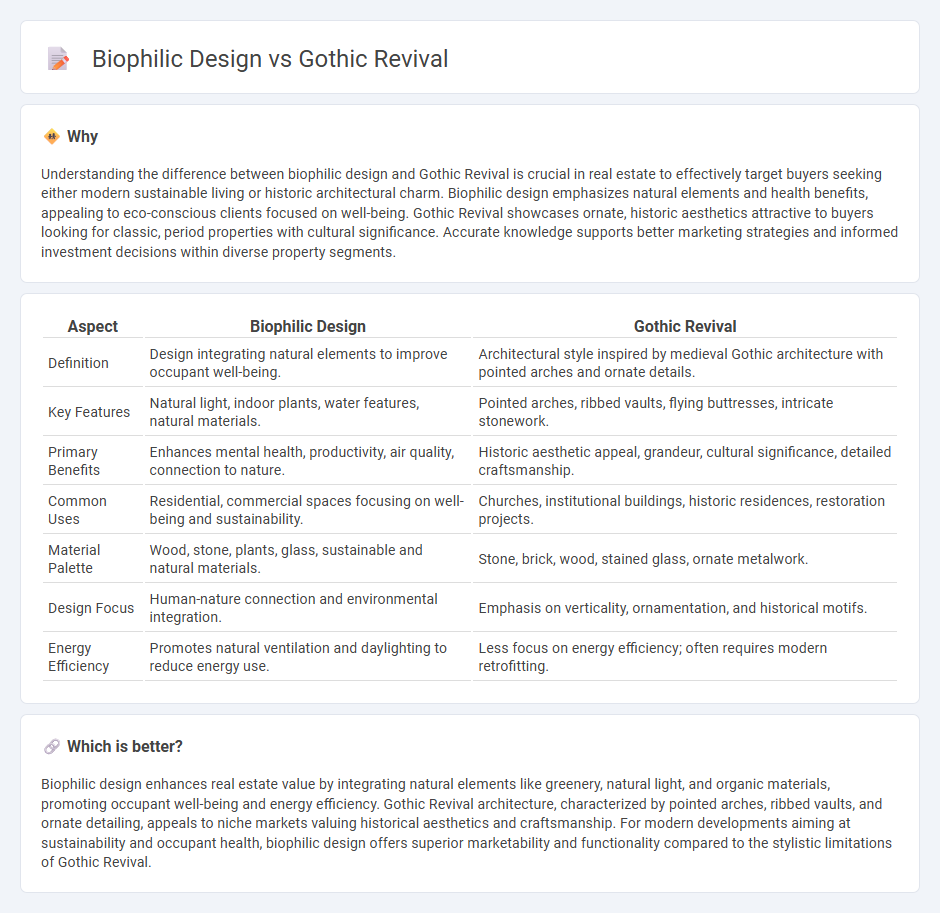
Biophilic design integrates natural elements such as sunlight, greenery, and organic materials into real estate spaces to enhance occupant well-being and environmental sustainability. Gothic Revival architecture emphasizes intricate details, pointed arches, and grandeur, reflecting historical and cultural significance in property aesthetics. Explore the unique advantages and design principles that distinguish biophilic design from Gothic Revival in real estate development.
Why it is important
Understanding the difference between biophilic design and Gothic Revival is crucial in real estate to effectively target buyers seeking either modern sustainable living or historic architectural charm. Biophilic design emphasizes natural elements and health benefits, appealing to eco-conscious clients focused on well-being. Gothic Revival showcases ornate, historic aesthetics attractive to buyers looking for classic, period properties with cultural significance. Accurate knowledge supports better marketing strategies and informed investment decisions within diverse property segments.
Comparison Table
| Aspect | Biophilic Design | Gothic Revival |
|---|---|---|
| Definition | Design integrating natural elements to improve occupant well-being. | Architectural style inspired by medieval Gothic architecture with pointed arches and ornate details. |
| Key Features | Natural light, indoor plants, water features, natural materials. | Pointed arches, ribbed vaults, flying buttresses, intricate stonework. |
| Primary Benefits | Enhances mental health, productivity, air quality, connection to nature. | Historic aesthetic appeal, grandeur, cultural significance, detailed craftsmanship. |
| Common Uses | Residential, commercial spaces focusing on well-being and sustainability. | Churches, institutional buildings, historic residences, restoration projects. |
| Material Palette | Wood, stone, plants, glass, sustainable and natural materials. | Stone, brick, wood, stained glass, ornate metalwork. |
| Design Focus | Human-nature connection and environmental integration. | Emphasis on verticality, ornamentation, and historical motifs. |
| Energy Efficiency | Promotes natural ventilation and daylighting to reduce energy use. | Less focus on energy efficiency; often requires modern retrofitting. |
Which is better?
Biophilic design enhances real estate value by integrating natural elements like greenery, natural light, and organic materials, promoting occupant well-being and energy efficiency. Gothic Revival architecture, characterized by pointed arches, ribbed vaults, and ornate detailing, appeals to niche markets valuing historical aesthetics and craftsmanship. For modern developments aiming at sustainability and occupant health, biophilic design offers superior marketability and functionality compared to the stylistic limitations of Gothic Revival.
Connection
Biophilic design in real estate integrates natural elements to enhance occupants' well-being, often drawing inspiration from historical architectural styles like Gothic Revival, which emphasizes organic forms and intricate detailing reminiscent of nature. Gothic Revival features such as pointed arches, ornate tracery, and verticality evoke a connection to natural patterns and spatial harmony, aligning with biophilic principles. Incorporating these elements in modern real estate developments creates immersive, nature-inspired environments that improve mental health and productivity.
Key Terms
Ornamentation
Gothic Revival ornamentation features intricate stone carvings, pointed arches, and detailed tracery inspired by medieval architecture, creating a sense of grandeur and historical depth. Biophilic design emphasizes organic patterns, natural materials, and plant motifs to foster a connection with nature and enhance well-being. Discover more about how these ornamentation styles impact architectural aesthetics and human experience.
Natural Elements
Gothic Revival architecture emphasizes intricate stone carvings, pointed arches, and stained glass windows that evoke a spiritual connection to nature through symbolic motifs rather than direct incorporation of natural elements. In contrast, Biophilic design integrates abundant natural materials, light, and living plants to foster well-being and create a tangible relationship with the environment. Explore how these design philosophies uniquely blend nature and structure in different historical and contemporary contexts.
Verticality
Gothic Revival architecture emphasizes verticality through pointed arches, ribbed vaults, and towering spires that create an impression of height and grandeur. Biophilic design uses vertical gardens, green walls, and natural textures to integrate plant life into built environments, promoting well-being and connection to nature. Explore how vertical elements shape experiences in both Gothic Revival and biophilic design to deepen your architectural understanding.
Source and External Links
Gothic Revival Architecture: Inside the History of ... - Gothic Revival was a nineteenth-century architectural movement inspired by medieval Gothic architecture, starting with the Abbey Church of Saint-Denis in France and popularized later in England with notable examples like the Palace of Westminster, characterized by pointed arches, towers, and rich ornamentation reflecting a romantic reaction against industrialization and classical styles.
Gothic Revival architecture - Gothic Revival architecture draws on medieval Gothic elements such as lancet windows and decorative patterns, driven by a religious and cultural nostalgia linked to evangelicalism and a reaction against industrialization, with figures like Augustus Pugin championing Gothic as embodying Christian values lost in modern times.
Gothic Revival | Definition, Style, Architecture, Examples, & ... - The Gothic Revival style emerged during the Romantic period as a revolt against Neoclassicism, inspired by medieval romance literature and historic church reform ideas, with key theorists like John Ruskin advocating a return to the craftsmanship and moral ideals of the medieval period as expressed through Gothic architectural forms.
 dowidth.com
dowidth.com